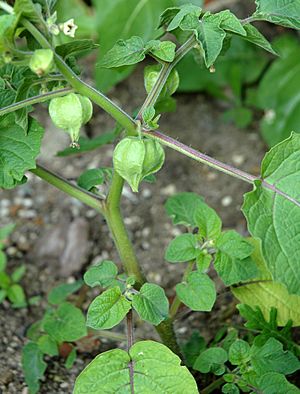Physalis pruinosa facts for kids
Quick facts for kids Physalis pruinosa |
|
|---|---|
 |
|
| Scientific classification | |
| Genus: |
Physalis
|
| Species: |
pruinosa
|
Physalis pruinosa is a cool plant often called a ground cherry or husk tomato. It belongs to the nightshade family, just like tomatoes and potatoes! This plant grows low to the ground and spreads out. Its fruits grow inside a papery husk, which looks a bit like a tiny lantern.
Contents
Discovering the Ground Cherry
This interesting plant is native to a wide area. You can find it growing naturally from northern Mexico all the way through Central America. It likes to spread out low to the ground, making it a unique sight in its natural habitat.
What Does the Ground Cherry Look Like?
The ground cherry plant has a low, spreading shape. Its most special feature is its fruit. Each fruit develops inside a papery husk. This husk is actually a part of the flower called a calyx. It protects the fruit as it grows.
Is the Ground Cherry Safe to Eat?
Most parts of the ground cherry plant are not safe to eat. They contain natural substances called solanine and solanidine, which can be harmful. However, the fruit itself becomes delicious and sweet once it is fully ripe! You'll know it's ready when it turns a bright yellow color. Remember, even when the fruit is ripe, the papery husk around it is still not safe to eat, so always remove it before tasting the fruit.
What Does the Fruit Taste Like?
The ripe ground cherry fruit has a unique and yummy flavor. Many people say it tastes a bit like a ripe tomatillo, which is another plant in the nightshade family. But what makes it truly special is its strong pineapple flavor! This is why one popular type of ground cherry is even called "Cossack Pineapple."
Why Is This Plant Being Studied?
Scientists are very interested in Physalis pruinosa. They are researching ways to make it easier to grow for food on a large scale. This research involves using a special tool called CRISPR. CRISPR helps scientists make tiny changes to the plant's genes. The goal is to make the ground cherry a more common and easier-to-grow crop for farmers everywhere. This process could help us get more delicious ground cherries to eat!
See also
 In Spanish: Physalis pruinosa para niños
In Spanish: Physalis pruinosa para niños

